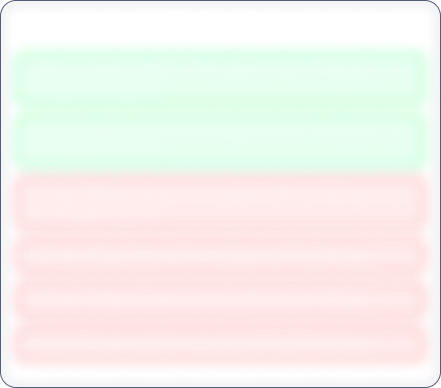Year End Sale 50% off
New India Assurance Company

No Data Available
Investor Sentiment
New India Assurance Company Share price and Fundamental Analysis
Key Metrics
Included In
Stock Returns
Stock Heatmap

No Stocks
Smart Score

Unlock Smart Score
See Detailed Analysis & Insights


Unlock Insights
See Detailed Analysis & Insights
Technicals
Returns Calculator
If you would have investedResearch Report
No Research Report
Corporate Action
Financials
Key Ratios
ROE
Avg ROE (3 Yrs) : NaN%
ROCE
Avg ROCE (3 Yrs) : NaN%
ROA
Avg ROA (3 Yrs) : NaN%
NPM
Avg NPM (3 Yrs) : NaN%
Dividend History
5 Year FactSheet
Documents

No Data Available
News
New India Assurance Company Management and History
Company Management


Unlock Management Data
See Detailed Analysis & Insights
Company History
The New India Assurance Company Limited is the largest general insurance company in India in terms of net worth, domestic gross direct premium, profit after tax and number of branches. The Company's operations are spread across 29 States and seven Union Territories in India and across 26 other countries globally through a number of international branches, agency offices and Subsidiaries including a desk at Lloyd's, London. The Company's insurance products can be broadly categorized into the following product verticals: fire insurance; marine insurance, motor insurance, crop insurance, health insurance and other insurance products. The Company is registered with IRDAI for carrying out the business of general insurance.
The New India Assurance Company Limited was incorporated as a Limited Company on July 23, 1919 at Mumbai, Maharashtra, India. The Company obtained the Certificate of Commencement of Business on October 14, 1919. In 1920, within one year of the incorporation of the Company, New India Assurance Company opened an office in London. After that, the Company saw a steady increase in presence abroad with Manila, Port Louis and Japan. In 1956, New India Assurance Company transferred life insurance business to the Life Insurance Corporation of India, which formed under the Life Insurance Corporation Act, 1956, pursuant to which life insurance business in India was nationalized.
In 1973, The General Insurance Corporation of India was formed under the General Insurance Business (Nationalization) Act, 1972, which provided for nationalization of general insurance business in India. New India Assurance Company became a subsidiary of the General Insurance Corporation of India after the Government of India (GoI) transferred its entire shareholding in general insurance companies to the General Insurance Corporation of India. Pursuant to the 1973 Scheme, which came into force on January 1, 1974, New India Assurance Company was nationalized by the Government of India. In 2003, pursuant to the General Insurance Business (Nationalization) Amendment Act, 2002, the General Insurance Corporation of India transferred its entire shareholding in New India Assurance Company to the GoI. New India Assurance Company crossed premium of Rs 10000 crore during 2011-12.
In 2016, the Company received approval for opening an office at Gujarat International Finance Tec-City, Gandhinagar. The Company crossed premium of Rs 20000 crore during 2016-17.
In November 2017, New India Assurance Company came out with an initial public offer (IPO). The IPO was a combination of fresh issue of shares by the company and offer for sale of a portion of its stake by Government of India (GoI). The stock debuted at Rs 748.90 on BSE on 13 November 2017 compared with IPO price of Rs 800 per share.
The Board of Directors of The New India Assurance Company Ltd at its meeting held on May 11, 2018, recommended issue of bonus shares in proportion of 1:1 (ie. 1 new bonus equity share of Rs. 5 each for every 1 equity shares of Rs. 5 each held), subject to approval of the shareholders.
During year 2019, Company's foreign operations saw a gross written premium turnover in rupee equivalent of Rs. 3530.37 crores and a Net Premium of Rs. 2839.09 crores in FY 2018-19. The foreign operations recorded an underwriting (loss) of Rs. (543.10) crores and Profit After Tax was Rs. (389..90) crores. It approved 67 New Micro Offices and opened 35 new Micro Offices. During year 2019, 10 Micro Offices were upgraded to Branch Offices and 18 Branch Offices were upgraded to Divisional Offices. As on 31st March 2019, the Company has a network of 31 Regional Offices, 7 Large Corporate Offices, 1 Auto Hub, 1 IFSC, 477 Divisional Offices, 594 Branch Offices, 25 Direct Agent Branches and 1257 Micro Offices, totaling 2395 offices inclusive of Head Office.
During the year 2019, 22 new products were launched by the Company. During FY2019, the Company issued Bonus Equity Shares of Rs. 5 each in the ratio of 1:1 to the existing shareholders of the Company for which, allotment date was 29 June, 2018.
During year 2020, the Company serviced more than 30 million policies. As on 31st March 2020, the Company has a network of 31 Regional Offices, 7 Large Corporate Offices, 1 Auto Hub, 1 office at International Financial Services Centre, 1 Digital Hub, 474 Divisional Offices, 591 Branch Offices, 25 Direct Agent Branches and 1160 Micro Offices, totaling 2292 offices inclusive of Head Office. The Company's foreign operations saw a gross written premium turnover in rupee equivalent of Rs. 3747.58 crores and a Net Premium of Rs. 3042.99 crores in FY 2019-20. The foreign operations recorded an underwriting profit of Rs. 73.31 crores and Profit After Tax was Rs. 214.91 crores. Gross Written Premium increased to Rs. 31244 crores, recording a growth of 11.52% in 2019-20. During the year 2020, two new products were approved by the Regulator - IRDAI (Stand Alone Motor Own Damage Policy for Two-Wheeler and for Private Car).
During FY2021, Global Gross Written Premium increased to Rs. 28663 crores, recording a growth of 6.16% in% in 2020-21. The Company's foreign operations saw a gross written premium turnover in rupee equivalent of Rs. 3888.83 crores and a Net Premium of Rs. 3070.24 crores in 2020-21. The foreign operations recorded an underwriting profit of Rs. 75.69 crores and Profit After Tax was Rs. 196.21 crores. During the year 2021, Company opened 1 Regional Government Business Office (RGBO) for better servicing and closed 1 Divisional Office, 2 Branch Offices and 76 Micro Offices.
During the year 2021, eight new products were approved by the Regulator - IRDAI (Nil Depreciation Add-on Cover under Commercial Vehicles, Roadside Assistance Add-On Cover under Annual Policy, Bundled Policy, Stand Alone Motor Own Damage Policy for Two-Wheeler and Private Car separately and under Long Term Two-Wheeler Package Policy for 2 & 3 years). During FY 2020-2021, Company selected Punjab Sind Bank as its General Insurance business partner. During the year 2021, Company opened 1 Micro Office for better servicing and closed 3 Branch offices and 41 Micro Offices.
During FY2022, Global Gross Written Premium increased to Rs. 32837 crores, recording a growth of 14.56% in 2021-22. The Company's foreign operations saw a gross written premium turnover in rupee equivalent of Rs. 3644.41 crores and a Net Premium of Rs. 2916.94 crores in 2021-22. The foreign operations recorded an underwriting loss of Rs 206.35 crores and Loss after Tax was Rs. 2.95 crores.
As on 31st March 2022, the Company has a network of 31 Regional Offices, 7 Large Corporate Offices, 1 Auto Hub, 1 RGBO,1 IFSC, 1 Digital Hub, 473 Divisional Offices, 584 Branch Offices, 25 Direct Agent Branches and 1046 Micro Offices, totaling 2171 offices inclusive of Head Office. New India Assurance has tie-up with PSU i.e. Canara Bank, Punjab and Sind Bank, Central Bank of India and 3 private banks including IDBI &1 foreign bank i.e. Citibank, besides 30 Scheduled Cooperative Banks during FY 2021-2022. In FY 2021-2022 Bancassurance contributed Rs 267.66 cr. premium income and ICR was 82.34%.
During FY2022, Global Gross Written Premium increased to Rs. 34800 crores, recording a growth of 5.98% in 2022-23. The Company's foreign operations saw a gross written premium turnover in rupee equivalent of Rs. 3,990.81 crores and a Net Premium of Rs. 3,245.75 crores in 2022-23. The foreign operations recorded an underwriting loss of Rs 263.71 crores and Loss after Tax was Rs. 107.14 crores.
As on 31st March 2023, the Company has a network of 31 Regional Offices, 7 Large Corporate Offices, 1 Auto Hub, 1 RGBO,1 IFSC, 1 Digital Hub, 469 Divisional Offices, 564 Branch Offices, 23 Direct Agent Branches and 816 Micro Offices, totaling 1915 offices inclusive of Head Office. New India Assurance has tie-up with PSU i.e. Canara Bank, Punjab and Sind Bank, Central Bank of India and 3 private banks including IDBI &1 foreign bank i.e. Citibank, besides 30 Scheduled Cooperative Banks during FY 2022-23. In FY 2022-23, Bancassurance contributed Rs 248.12 cr. premium income and ICR was 82.34%.
New India Assurance Company Share Price
New India Assurance Company share price reflects investor sentiment toward the company and is impacted by various factors such as financial performance, market trends, and economic conditions. Share price is an indicator which shows the current value of the company's shares at which buyers or sellers can transact.
New India Assurance Company Market Cap
Market capitalization of New India Assurance Company indicates the total value of its outstanding shares. Marketcap is calculated by multiplying share price and outstanding shares of the company. It is a helpful metric for assessing the company's size and market Valuation. It also helps investors understand how New India Assurance Company is valued compared to its competitors.
New India Assurance Company PE Ratio
New India Assurance Company PE ratio helps investors understand what is the market value of each stock compared to New India Assurance Company 's earnings. A PE ratio higher than the average industry PE could indicate an overvaluation of the stock, whereas a lower PE compared to the average industry PE could indicate an undervaluation.
New India Assurance Company PEG Ratio
The PEG ratio of New India Assurance Company evaluates its PE ratio in relation to its growth rate. A PEG ratio of 1 indicates a fair value, a PEG ratio of less than 1 indicates undervaluation, and a PEG ratio of more than 1 indicates overvaluation.
New India Assurance Company ROE (Return on Equity)
Return on Equity (ROE) measures how effectively New India Assurance Company generates profit from shareholders' equity. A higher ROE of more than 20% indicates better financial performance in terms of profitability.
New India Assurance Company ROCE (Return on Capital Employed)
Return on Capital Employed (ROCE) evaluates the profitability of New India Assurance Company in relation to its capital employed. In simple terms, ROCE provides insight to investors as to how well the company is utilizing the capital deployed. A high ROCE of more than 20% shows that the business is making profitable use of its capital.
New India Assurance Company Total Debt
Total debt of New India Assurance Company shows how much the company owes to either banks or individual creditors. In simple terms, this is the amount the company has to repay. Total debt can be a very useful metric to show the financial health of the company. Total debt more than equity is considered to be a bad sign.
New India Assurance Company Debt to Equity Ratio
The Debt-to-Equity (DE) ratio of New India Assurance Company compares its total debt to shareholders' equity. A higher Debt to Equity ratio could indicate higher financial risk, while a lower ratio suggests that the company is managing its debt efficiently.
New India Assurance Company CAGR (Compound Annual Growth Rate)
CAGR shows the consistent growth rate of New India Assurance Company over a specific period, whether it is over a month, a year, or 10 years. It is a key metric to evaluate the company’s long-term growth potential. Main metrics for which CAGR is calculated are net sales, net profit, operating profit, and stock returns.
New India Assurance Company Technical Analysis
Technical analysis of New India Assurance Company helps investors get an insight into when they can enter or exit the stock. Key components of New India Assurance Company Technical Analysis include:
Support Levels (S1, S2, S3)
There are usually multiple support levels, but the main support levels for a stock are S1, S2, S3. Support levels indicate price points where stock might get support from buyers, helping the stock stop falling and rise.
Resistance Levels (R1, R2, R3)
There are usually multiple resistance levels, but the main resistance levels for a stock are R1, R2, R3. Resistance levels represent price points where New India Assurance Company shares often struggle to rise above due to selling pressure.
New India Assurance Company Dividends
Dividends refer to the portion of the company’s profits distributed to its shareholders. Dividends are typically paid out in cash and reflect New India Assurance Company ’s financial health and profitability.
New India Assurance Company Bonus Shares
Bonus shares are usually given by companies to make the stock more affordable, increase liquidity, boost investor confidence, and more.
New India Assurance Company Stock Split
Stock split increases the number of its outstanding shares by dividing each existing share into multiple shares. When the company offers a stock split, the face value of the stock reduces in the same proportion as the split ratio.
New India Assurance Company Financials
The financials of New India Assurance Company provide a complete view to investors about its net sales, net profit, operating profits, expenses, and overall financial health. Investors can analyze financial data to assess the company’s stability and also understand how the company has been growing financially.
New India Assurance Company Profit and Loss Statements
The profit and loss statement of New India Assurance Company highlights its net sales, net profit, total expenditure, and operating profits in the current financial year. This Profit and Loss statement is crucial for evaluating the profitability and financial stability of New India Assurance Company .
New India Assurance Company Balance Sheet
The balance sheet presents a snapshot of New India Assurance Company ’s assets, liabilities, and equity of shareholders, providing insights into the financials of the company.
New India Assurance Company Cashflow Statements
Cashflow statements track the company's cash inflows and outflows over a period. It is an essential tool for understanding how well the company manages its liquidity and finances.
New India Assurance Company Price-to-Book Ratio (P/B Ratio)
New India Assurance Company Price-to-book ratio is used by many investors to compare a company's market capitalization to its book value and find undervalued companies.


